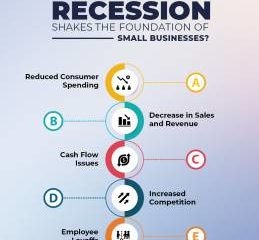Politics
How Small Businesses Can Shield Themselves Against Cyberattack
Published
1 year agoon
By
Drew Simpson
As businesses become increasingly digital, adapting to consumer demand, and swiftly transitioning towards the online world, ongoing threats of cybercrime and cyberattacks are becoming a significant challenge for small businesses that are ill-prepared.
There are Digital Tools to Help Defend Against Cyberattack
Today, with the onset of digital tools that can help businesses remain relevant in the highly competitive marketplace, new technologies exist in different spheres of the business ecosystem to help find solutions to the growing problems business owners are constantly facing.
New technologies are helping business owners and employees cope with high volumes of work or better manage customer relations. They also act as a guard between the business and bad actors looming on the internet.
Part of the transition into the digital ecosystem has also come with a range of costly challenges.
In recent years, the rise of cyber-attacks and bad actors has meant that businesses are seeing a growing threat that could potentially jeopardize their operations and cost them a pretty penny to resolve.
In today’s world, cybersecurity and online data protection should be considered one of the leading strategic solutions to improve business performance.
The latest statistics reveal that as of 2022, the average cost per data breach amounted to more than $4.35 million, a steady increase from the recorded average of $4.24 million.
While the cost of a data breach may vary from industry to industry, healthcare and medicine were seen as having the highest recorded average cost.
There is a Mind-Boggling Amount of Data Breaches and Cyberattacks
The staggering price tag of data breaches meant that small and big businesses have swiftly acted to counter any potential attacks and breaches by implementing an array of tools that can mitigate the potential threat of any bad actors.
A report published in 2021 shows that small businesses have become prime targets for hackers and cybercriminals. Around 42% of businesses were affected by cyberattacks last year, according to the report. On top of this, it was found that 69% of small business professionals said they are concerned about any potential future attacks.
Even with 72% of small business owners and managers now preparing their digital operations for a potential attack, many professionals still regard their businesses as too small or out of sight of cyber criminals to be considered targets.
The concern is that only 26% of small business professionals currently see or regard cyber security as a “top priority.” Even with the current state of cyber security, small businesses will only see a growing number of threats in the coming years as widespread technological adoption and internet usage occur.
The basket of challenges, other than cyber attacks, is that small businesses and startups are generally not in a financial position to implement high-end cyber security systems.
Setting up a high-end or medium-tier cybersecurity system could cost professionals between $1,300 and $3,000 per full-time employee.
While percentage-wise, it means that the business is dedicating between 0.2% to 0.9% of its revenue to cybersecurity, for a small business owner like yourself, these figures could mean having to make financial cutbacks or adjustments to the budget to improve online digital security systems.
Types of cyberattack
With the exponential growth of online commerce and digital media paired with the onset of remote work and the virtual working office, the types of cyberattacks businesses face annually are becoming more severe and costing them more each year.
Despite the advancement in technology and the Internet of Things (IoT), and basic software capabilities, it’s been found that human error remains the most significant cause of cyberattacks due to insufficient knowledge and training on cyber security and cybercrime.
While human error remains the biggest pitfall for small businesses when it comes to their cybersecurity, other types of attacks and threats include:
Malware Attack:
This refers to malicious software that infiltrates a computer or operating system with a virus, such as worms, spyware, ransomware, and adware. Malware attacks are among the most common types of cyber attacks.
Phishing Attack:
Another widespread threat includes the use of malicious links and emails, if once opened, a virus is then released onto the computer or operating system, whereby an attacker gains access to confidential information and data.
Password Attack:
Hackers can infiltrate a business’s online platforms and other important information by cracking the password for a specific portal or account. Any person must always use a strong and complex password, especially if multiple accounts are synced or connected to the same server.
Denial-of-Service Attack:
Common among businesses and companies and involves attackers flooding a company’s servers and networks to exhaust the bandwidth. Once the system becomes overwhelmed or exhausted, it tends to slow down or shut down completely, leaving the server and networks compromised.
These are only a few of the most common and widely known cyberattacks that occur regularly. For small businesses that use online platforms such as social media or any eCommerce site, an online attack can occur at any given moment. It usually takes a few days before a person even realizes a system has become compromised.
What small businesses can do to protect themselves against cyber attacks
With a growing list of potential cyber threats, as a small business owner or startup entrepreneur, having to differentiate between obscure and bad actors will become increasingly challenging as the types of cyberattacks only become more complex and advanced.
Being prepared as best as possible means that you protect your business, employees, and customers. Take a look at some tips below to help protect your business against impending cybercrime.
Educate and inform employees
Whether you operate a small business with one, two, or a couple of dozen employees, the best place to start is with your frontline personnel to ensure they are educated and informed about the risks of cyberattacks. Even if you are a one-person/woman show, take the time to follow up about a potential gap in your cyber security system and how you can fix it.
Employees may be the most significant risk for your business’s cybersecurity, so the best way to go about this is to ensure that when an employee logs into social media accounts or visits websites for personal reasons, it is done on their own devices.
You can also create a password policy that mandates employees to secure their work devices with passwords and that it is updated regularly. The first line of defense is to ensure employees can spot suspicious online activity and have a protocol to resolve the issue.
Limit employee data access
As part of educating employees about the dangers of cyber attacks, you can also limit the number of access employees has to business-related data and information.
While still a small business, giving one or two employees unlimited access to all business information and customer data is never a good idea. However, limiting what employees can see, enter, and download makes it easier for you, a business owner, to control and monitor what types of data sets are being accessed, by whom, and for what purposes.
Update software and cybersecurity systems
During the early stages of your business, it’s essential to take a bit of time and consider whether your personal computer, which is often used for business-related activities, has some form of anti-virus or, at a minimum, anti-spyware software installed.
This is the most basic level of security for any type of computer, but as your business begins to grow and more devices get added, it’s essential to update systems as you progress. From smartphones, tablets, computers, and laptops to online websites and social media accounts, ensure a strong wall of protection between your business and any bad actors that can hack your data.
Make use of cloud storage
Online cloud storage has, in recent years, become a suitable replacement for servers and hardware networks that were used to store data and information. And while many businesses still use these hardware tools, advanced technology has, in due time, decreased its need and safety, replacing it with virtual cloud storage capabilities.
With cloud storage, you can directly upload and download any information, share across multiple channels, improve virtual and remote working capabilities, and operate a more mobile-friendly work environment for remote employees.
Cloud storage also happens to be a lot more stable and offers around-the-clock cybersecurity protection. What’s more, you can monitor cloud activity to see if you can spot any suspicious activities or update security protocols.
Regularly conduct cybersecurity assessments
Another intelligent and cost-effective way to improve cybersecurity systems is to conduct cybersecurity assessments on your devices and operating systems routinely. Usually, this is relatively easy, especially if you’re using a basic computer security program or if you have the know-how skills.
Running the assessments not only helps monitor your devices’ performance, but it can also help you pick up any type of possible threats and clear a device from viruses, worms, and trojans.
Typically computer security programs come with a built-in assessment tool that you can launch by yourself or do a bit of research online about free and trusted tools you can use.
Set up customer data protection
Any type of small business that operates online through social media or a website will need to implement some form of customer data protection to help secure your client’s personal information.
For starters, you can restrict which employees have access to customer information and to what extent they can use customer data.
Secondly, use a customer relationship management system that is trusted by the industry and offers reliable protection against hackers from inside and outside the business.
Finally, limit the amount of data and information stored on devices or network servers to minimize accessibility.
Securing customer data means that you protect not only your customers, but in case of a potential hack or cyberattack, customers can be assured your business has the needed protocols in place that will counter any bad actors.
Set up a response plan
A final recommendation would be to set up a response plan in case of an attack or data breach. Before setting up a response plan, it’s advised to consult with a professional or do some research on the protocols you should follow and have in place in case cybercriminals gain access to your business data.
A response plan can also help employees in the event of a possible attack. It helps you, as a business owner, know that you are well-prepared and have taken the necessary steps to implement the proper protocols.
To end off
As a business owner, it’s best to be prepared rather than run the risk of leaving your business, employees, and customers vulnerable in the face of cybercrime. Having a heavy hand in protecting data and information ensures that all channels of your business can be protected and that when an attack occurs, you have the proper protocols to mitigate any costly threats.
Never think your business is too small to be a victim of a cyberattack. Cybercrime has become a growing threat for any size business. As bad actors become more innovative and advanced, it will only cost business owners more money and resources to resolve cybercrime.
Cybersecurity is a permanent and long-term investment that should be considered throughout all aspects of the business. Using suitable systems and tools will save you a lot of time and money, keep your information secure, and counter any bad actors looming and watching.
Published First on Calendar. Read Here.
Featured Image Credit: Photo by Anete Lusina; Pexels; Thank you!
Calendar
We are Calendar, trying to make the world a much more productive place. Check us out online at https://www.calendar.com.
You may like
-


The businesses changing climate technology
-


Top of Heart: New Book Reveals the Mindset Creating 7-Figure Businesses
-


Social Media Management: Small Businesses Can Effectively Manage Time Online
-


Automated Threat Hunting: How AI Can Help Businesses Spot Shady Network Activity
-


Adapt, Innovate, Succeed: A Guide To Recession-Proofing Your Small Business
-


The Risks AI Poses For Small Businesses That Automate Too Quickly
Politics
Fintech Kennek raises $12.5M seed round to digitize lending
Published
7 months agoon
10/11/2023By
Drew Simpson
London-based fintech startup Kennek has raised $12.5 million in seed funding to expand its lending operating system.
According to an Oct. 10 tech.eu report, the round was led by HV Capital and included participation from Dutch Founders Fund, AlbionVC, FFVC, Plug & Play Ventures, and Syndicate One. Kennek offers software-as-a-service tools to help non-bank lenders streamline their operations using open banking, open finance, and payments.
The platform aims to automate time-consuming manual tasks and consolidate fragmented data to simplify lending. Xavier De Pauw, founder of Kennek said:
“Until kennek, lenders had to devote countless hours to menial operational tasks and deal with jumbled and hard-coded data – which makes every other part of lending a headache. As former lenders ourselves, we lived and breathed these frustrations, and built kennek to make them a thing of the past.”
The company said the latest funding round was oversubscribed and closed quickly despite the challenging fundraising environment. The new capital will be used to expand Kennek’s engineering team and strengthen its market position in the UK while exploring expansion into other European markets. Barbod Namini, Partner at lead investor HV Capital, commented on the investment:
“Kennek has developed an ambitious and genuinely unique proposition which we think can be the foundation of the entire alternative lending space. […] It is a complicated market and a solution that brings together all information and stakeholders onto a single platform is highly compelling for both lenders & the ecosystem as a whole.”
The fintech lending space has grown rapidly in recent years, but many lenders still rely on legacy systems and manual processes that limit efficiency and scalability. Kennek aims to leverage open banking and data integration to provide lenders with a more streamlined, automated lending experience.
The seed funding will allow the London-based startup to continue developing its platform and expanding its team to meet demand from non-bank lenders looking to digitize operations. Kennek’s focus on the UK and Europe also comes amid rising adoption of open banking and open finance in the regions.
Featured Image Credit: Photo from Kennek.io; Thank you!
Radek Zielinski
Radek Zielinski is an experienced technology and financial journalist with a passion for cybersecurity and futurology.
Politics
Fortune 500’s race for generative AI breakthroughs
Published
7 months agoon
10/11/2023By
Drew Simpson
As excitement around generative AI grows, Fortune 500 companies, including Goldman Sachs, are carefully examining the possible applications of this technology. A recent survey of U.S. executives indicated that 60% believe generative AI will substantially impact their businesses in the long term. However, they anticipate a one to two-year timeframe before implementing their initial solutions. This optimism stems from the potential of generative AI to revolutionize various aspects of businesses, from enhancing customer experiences to optimizing internal processes. In the short term, companies will likely focus on pilot projects and experimentation, gradually integrating generative AI into their operations as they witness its positive influence on efficiency and profitability.
Goldman Sachs’ Cautious Approach to Implementing Generative AI
In a recent interview, Goldman Sachs CIO Marco Argenti revealed that the firm has not yet implemented any generative AI use cases. Instead, the company focuses on experimentation and setting high standards before adopting the technology. Argenti recognized the desire for outcomes in areas like developer and operational efficiency but emphasized ensuring precision before putting experimental AI use cases into production.
According to Argenti, striking the right balance between driving innovation and maintaining accuracy is crucial for successfully integrating generative AI within the firm. Goldman Sachs intends to continue exploring this emerging technology’s potential benefits and applications while diligently assessing risks to ensure it meets the company’s stringent quality standards.
One possible application for Goldman Sachs is in software development, where the company has observed a 20-40% productivity increase during its trials. The goal is for 1,000 developers to utilize generative AI tools by year’s end. However, Argenti emphasized that a well-defined expectation of return on investment is necessary before fully integrating generative AI into production.
To achieve this, the company plans to implement a systematic and strategic approach to adopting generative AI, ensuring that it complements and enhances the skills of its developers. Additionally, Goldman Sachs intends to evaluate the long-term impact of generative AI on their software development processes and the overall quality of the applications being developed.
Goldman Sachs’ approach to AI implementation goes beyond merely executing models. The firm has created a platform encompassing technical, legal, and compliance assessments to filter out improper content and keep track of all interactions. This comprehensive system ensures seamless integration of artificial intelligence in operations while adhering to regulatory standards and maintaining client confidentiality. Moreover, the platform continuously improves and adapts its algorithms, allowing Goldman Sachs to stay at the forefront of technology and offer its clients the most efficient and secure services.
Featured Image Credit: Photo by Google DeepMind; Pexels; Thank you!
Deanna Ritchie
Managing Editor at ReadWrite
Deanna is the Managing Editor at ReadWrite. Previously she worked as the Editor in Chief for Startup Grind and has over 20+ years of experience in content management and content development.
Politics
UK seizes web3 opportunity simplifying crypto regulations
Published
7 months agoon
10/10/2023By
Drew Simpson
As Web3 companies increasingly consider leaving the United States due to regulatory ambiguity, the United Kingdom must simplify its cryptocurrency regulations to attract these businesses. The conservative think tank Policy Exchange recently released a report detailing ten suggestions for improving Web3 regulation in the country. Among the recommendations are reducing liability for token holders in decentralized autonomous organizations (DAOs) and encouraging the Financial Conduct Authority (FCA) to adopt alternative Know Your Customer (KYC) methodologies, such as digital identities and blockchain analytics tools. These suggestions aim to position the UK as a hub for Web3 innovation and attract blockchain-based businesses looking for a more conducive regulatory environment.
Streamlining Cryptocurrency Regulations for Innovation
To make it easier for emerging Web3 companies to navigate existing legal frameworks and contribute to the UK’s digital economy growth, the government must streamline cryptocurrency regulations and adopt forward-looking approaches. By making the regulatory landscape clear and straightforward, the UK can create an environment that fosters innovation, growth, and competitiveness in the global fintech industry.
The Policy Exchange report also recommends not weakening self-hosted wallets or treating proof-of-stake (PoS) services as financial services. This approach aims to protect the fundamental principles of decentralization and user autonomy while strongly emphasizing security and regulatory compliance. By doing so, the UK can nurture an environment that encourages innovation and the continued growth of blockchain technology.
Despite recent strict measures by UK authorities, such as His Majesty’s Treasury and the FCA, toward the digital assets sector, the proposed changes in the Policy Exchange report strive to make the UK a more attractive location for Web3 enterprises. By adopting these suggestions, the UK can demonstrate its commitment to fostering innovation in the rapidly evolving blockchain and cryptocurrency industries while ensuring a robust and transparent regulatory environment.
The ongoing uncertainty surrounding cryptocurrency regulations in various countries has prompted Web3 companies to explore alternative jurisdictions with more precise legal frameworks. As the United States grapples with regulatory ambiguity, the United Kingdom can position itself as a hub for Web3 innovation by simplifying and streamlining its cryptocurrency regulations.
Featured Image Credit: Photo by Jonathan Borba; Pexels; Thank you!
Deanna Ritchie
Managing Editor at ReadWrite
Deanna is the Managing Editor at ReadWrite. Previously she worked as the Editor in Chief for Startup Grind and has over 20+ years of experience in content management and content development.
